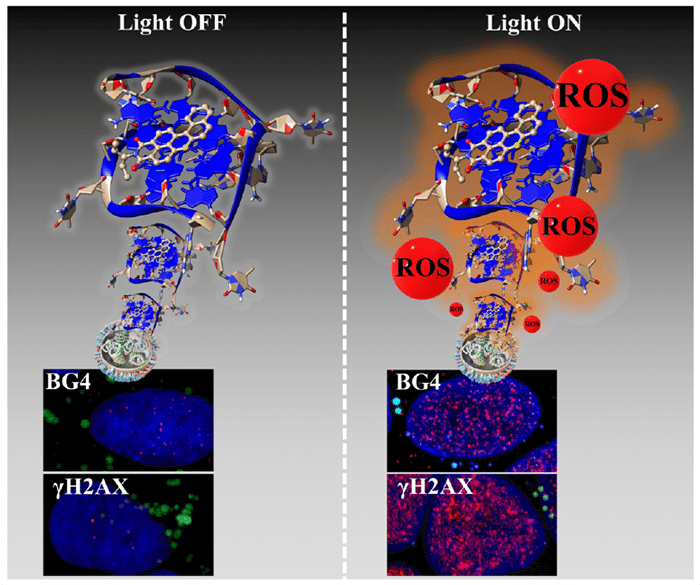A new molecule to target and eliminate cancer cells using light
This new photosensitizer has proved much more effective than those used in current treatments.
Advertisement
Scientists from CNRS, ENS Lyon, Université d'Angers and Université Claude Bernard Lyon 1, with the participation of Swedish and South Korean institutions, have developed a new molecule capable of accumulating specifically in cancer cells, and becoming toxic on contact with light. In the laboratory, it proved more effective than current treatments of this type, even when used in much lower concentrations.

Confocal fluorescence microscopy of cancer cells (BG4 and γH2AX) in the presence of the new photosensitizer compound. On the left of the image (before irradiation), the cell nucleus is marked by a blue fluorescent dye, while the photosensitizer localization appears as green fluorescent vesicles. On the right (under photo-irradiation), the photosensitizer generates Reactive Oxygen Species (ROS), which are extremely toxic to the cell. Affected areas appear as red fluorescent dots. Above these microscopic images is a model of the complexes formed between specific DNA sequences (telomeres) and the photosensitizer.
© Sabouri et al. / Nucleic Acids Research
Primarily used in the treatment of certain cancers, photodynamic therapies are minimally invasive treatments. They are based on the use of photosensitizers, molecules capable of becoming excited on contact with light and transmitting their energy to the oxygen contained in the targeted cells, rendering it toxic and causing cell death.
Through an interdisciplinary and international collaboration, scientists from the Chemistry Laboratory (CNRS/ENS Lyon), the Building Blocks for Future Electronics Laboratory (CNRS/Sorbonne University/Yonsei University) in South Korea, the Moltech-Anjou Laboratory (CNRS/Université d'Angers) and their South Korean colleagues have designed a new photosensitizer, called DBI. This molecule proved to be much more effective than the photosensitizers used in current treatments, enabling it to be used at therapeutic doses 10 to 100 times lower. The use of DBI could thus minimize possible adverse effects on healthy tissue. This efficacy was characterized and tested in vitro on human cells and in vivo on zebrafish embryos by their Swedish colleagues.
DBI was developed from a dye originally used by the textile industry and produced annually on a scale of several tonnes. By chemically modifying its structure, the scientists gave it new photosensitizing properties. In addition, DBI has also acquired the structural ability to interact with DNA contained in exosomes, components overexpressed in cancer cells. The photosensitizer thus accumulates preferentially in these key cellular compartments of cancer cells, where oxidative stress generated by exposure to light leads to DNA degradation and ultimately cell death.
Further studies are underway to determine whether this molecule will be suitable for clinical use.
Note: This article has been translated using a computer system without human intervention. LUMITOS offers these automatic translations to present a wider range of current news. Since this article has been translated with automatic translation, it is possible that it contains errors in vocabulary, syntax or grammar. The original article in French can be found here.
Original publication
Marco Deiana, José María Andrès Castán, Pierre Josse, Abraha Kahsay, Darío Puchán Sánchez, Korentin Morice, Natacha Gillet, Ranjitha Ravindranath, Ankit Kumar Patel, Pallabi Sengupta, et al.; "New G-quadruplex-specific photosensitizer inducing genome instability in cancer cells by triggering oxidative DNA damage and impeding replication fork progression."; Nucleic Acids Research, 2023.



























































